Contents
Market Overview
Macro Review
The week in which we saw Lagarde pivot. Speakers out of the ECB have turned notably hawkish after comments from Kazaks, Wunsch and Nagel. Lagarde almost sung from the same hymn sheet insofar as a rate lift-off in July, with the market pricing in a probability of 80% and then 70bp is priced into year-end. Equally, the U.S. 10-year Treasury is now in the most oversold territory since 1981. We have already seen a shift with BAML recommending clients to lean into 10-year Treasuries. Consensus is increasingly beginning to focus on growth drivers pressuring yields in the months ahead, although there is still caution around the 2-year yield which trades in chaotic fashion, but curves are expected to flatten after the recent bout of bear steepening. Needless to say, the committee hawks at both the ECB and Fed have consistently sought to move the goalposts and indeed this has led to a repricing of risk premia in interest rates. Surprises elsewhere were telegraphed by Bank of Canada and Bank of New Zealand who have already reacted by hiking 50bp at their recent meetings. Less can be said for the Bank of Japan. The JPY remains under pressure as the BoJ consistently intervened to buy JGBs and defend 25bp on the 10-year rate under the yield curve control policy. This has led to worries that they may have to intervene in the FX market – a development last seen in 1998. The other focus of the week was on the IMF spring meetings, which we discuss in more detail below.
EM Credit Update
Emerging market sovereign credit ended the week down 0.9% with spreads some 8bp wider. Outperformers over the week were Tunisia, Sri Lanka and Papua New Guinea, while Ukraine, El Salvador and Argentina underperformed. Most of the focus was indeed on the IMF spring meetings, with three major themes: (1) the uneven impact of higher food and commodity prices leading to inflation shocks; (2) the need for drastic changes in European energy and even fiscal policy; and (3) the more striking policy divergences between the US (tightening) and China (easing), but also the loose policy in Japan. As such the IMF cut its 2022 global growth forecast by 0.8% to 3.6% (more below). Stagflation fears are abound with Europe seen as the weak link and as such we have seen a more pronounced repricing in U.S. Treasuries and European rates.
The Week Ahead
French elections and Bank of Japan policy are the key fixtures for next week. Of equal importance are the data fireworks in the U.S. with 1Q GDP, PCE, employment cost index, durables, consumer confidence and housing data. In EM, China’s manufacturing PMI will be a test after CNH weakness, although with recent lockdowns in Shanghai a reading below 50 for a fourth consecutive month is likely. Key interest rate decisions are then due out of Colombia (5.0%), Kazakhstan (13.5%) and Russia (17.0%). The calendar is lighter across EM inflation, although Poland will be closely watched after the last print surprised to the upside, then an update is also due out of Brazil. Finally, we can expect to see 1Q GDP out of Mexico, South Korea and Taiwan.
Highlights from emerging markets discussed below include: Moves by the IMF, the Russia-Ukraine war enters a new phase and our thoughts on EM corporate bond buy backs.
Fixed Income
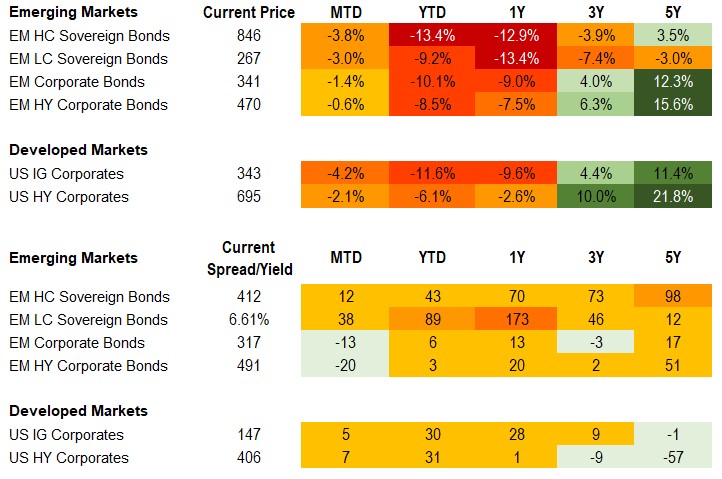
Equities
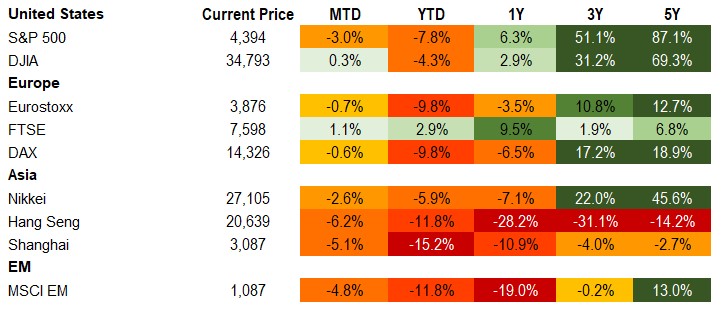
Commodities

Source for data tables: Bloomberg, JPMorgan, Gramercy. EM Fixed Income is represented by the following JPMorgan Indicies: EMBI Global, GBI-EM Global Diversified, CEMBI Broad Diversified and CEMBI Broad High Yield. DM Fixed Income is represented by the JPMorgan JULI Total Return Index and Domestic High Yield Index. Fixed Income, Equity and Commodity data is as of April 22, 2022 (mid-afternoon).
Emerging Markets Weekly Highlights
IMF unsurprisingly downgrades global growth forecasts and raises inflation estimates
Event: The Fund cut its 2022 world real GDP forecast by 0.8% points to 3.6% while raising inflation assumptions for developed and emerging economics by 1.8% and 2.8% points, respectively, to 5.7% and 8.7%. Downward revisions were generally broad-based with the largest reductions in Europe led by Ukraine and Russia. China growth was lowered to 4.4% just over 1% point below the government’s target.
Gramercy Commentary: We see the report as largely in line with market expectations albeit with somewhat greater uncertainty than current market sentiment suggests. While near-term risks remain high and skewed to the downside, as the report outlines, we’re encouraged over the medium-term that the IMF expects a significant improvement to the EM-DM growth differential into 2023 and still sees reasonably well-anchored inflation expectations over the long-term. We agree with the outlook’s assessment for near-term differentiation with the war-related commodity price shock having the greatest effects in Europe, the Middle East, and Africa while key economic drivers in the U.S. and Latin America will be policy tightening and inflation.
Russian offensive in Eastern Ukraine likely to trigger incrementally stronger Western sanctions pressure as conflict moves to a new stage
Event: The Russia-Ukraine war appears to have entered a new stage this week, in which the Kremlin has refocused its military campaign on capturing the entire Donbas administrative region in eastern Ukraine and completing a so called “land bridge” between Donbas and Crimea.
Gramercy commentary: As we have been cautioning in recent commentaries on the war in Ukraine, the relative positions and incentives on the ground point to continued intense fighting in the coming weeks and slim chances for ceasefire/peace talks in the near-term. President Putin appears eager to claim a “military victory” on time for the annual May 9 Victory Day parade in Moscow, which might partly explain Russia’s apparent shift in strategy toward a “smaller prize” (i.e. Donbas as opposed to Kyiv/Ukraine). The other explanation is of course Ukraine’s fierce resistance supported by a steady flow of Western military and financial aid. Against this backdrop, we expect the unfolding “Battle for Donbas” to involve heavy fighting amid Russia’s goal to achieve dominance over the region in a short period of time and Ukraine’s determination to defend it. Meanwhile, the fighting in Donbas and further evidence likely surfacing on atrocities against civilians from other Ukrainian territories previously occupied by Russian troops could gradually build a stronger political consensus in Europe for sanctions against Russia’s energy exports, leading to more significant restrictions over time. From a global macroeconomic perspective, this would increase downside risks to GDP growth and upside risks to inflation, raising the odds of a “stagflation” scenario for many DM and EM economies.
Global emerging markets corporates in focus: Bond buybacks
Event: Issuers carry out buybacks and other liability management exercises for a myriad of reasons. Concerns about rising rates notwithstanding, liability management exercises have continued unabated. We consider a few reasons why issuers may choose these corporate actions.
Gramercy commentary: Bond buybacks are often accompanied by new issues, as companies look to take advantage of more favorable financing conditions, replacing relatively expensive securities with cheaper ones. Such exercises may also take place to lengthen maturity profiles. Companies may also buy back bonds with the intention of locking in declines in the prices of liabilities. Such buybacks have sometimes been drivers of significant boosts to the bottom line. Bonds may be repurchased prior to the final maturity if regulations make keeping these securities outstanding more costly. Covenant breaches caused by the depreciation of the local currency may also mean issuers choose to buy back foreign currency-denominated securities, to remedy such breaches. Buybacks have sometimes taken place a short time after new issues. This may happen where the funds are no longer required, such as where M&A transactions fall through. Issuers may also choose to use proceeds from asset sales or other exceptional gains to repurchase liabilities. Finally, in severely dislocated markets, buybacks can provide investors with much-needed liquidity.
Emerging Markets Technicals
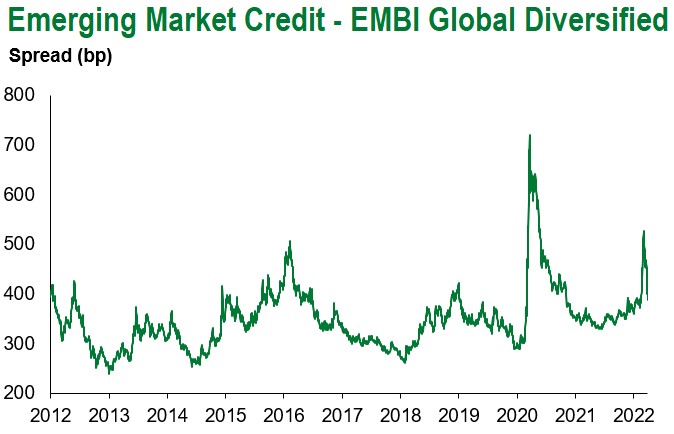
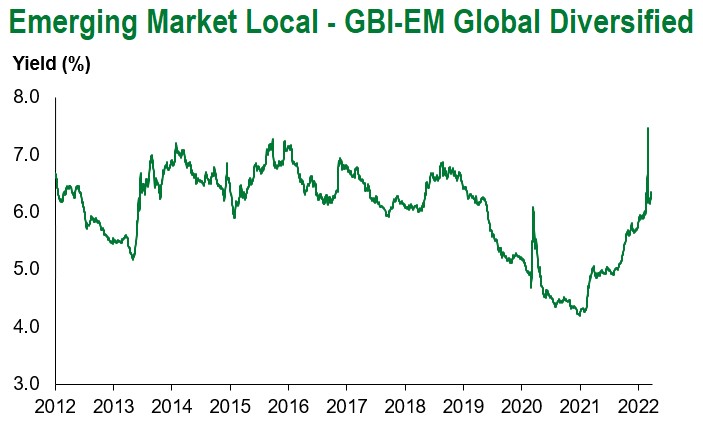
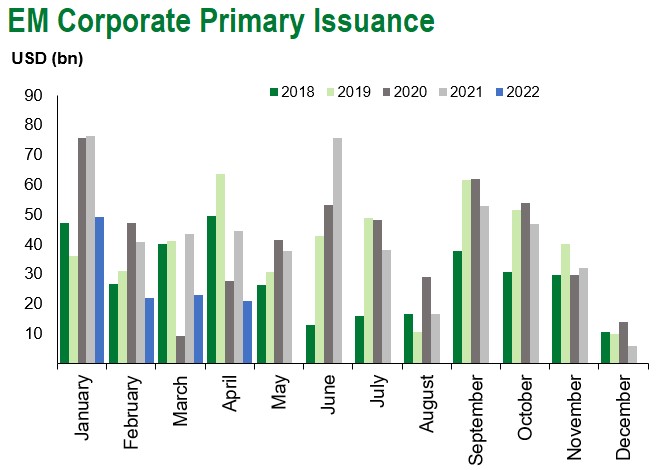
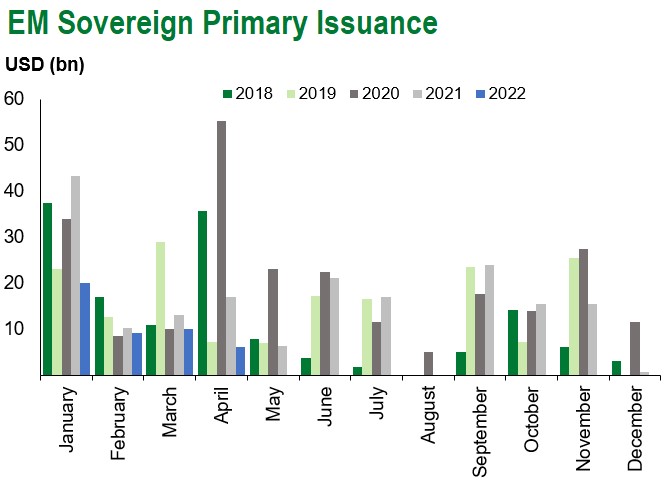
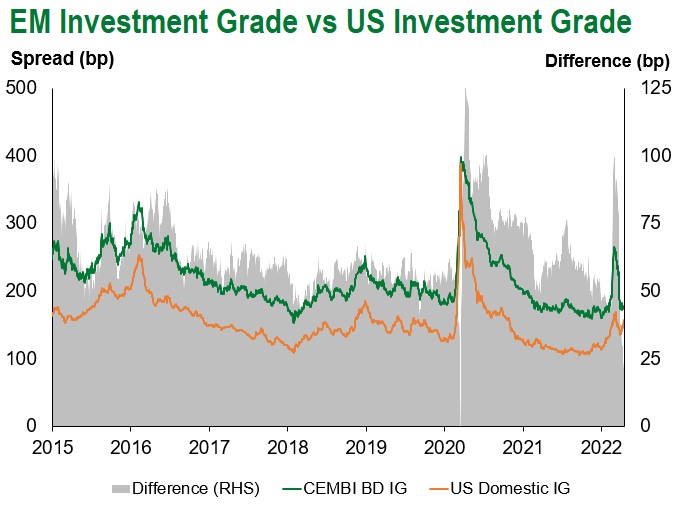
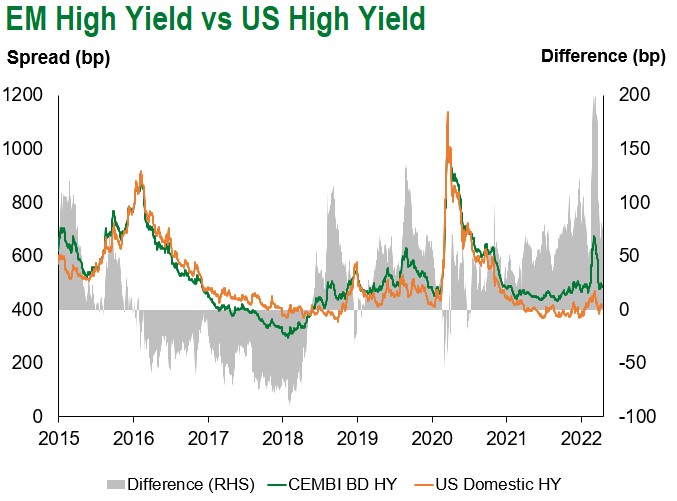
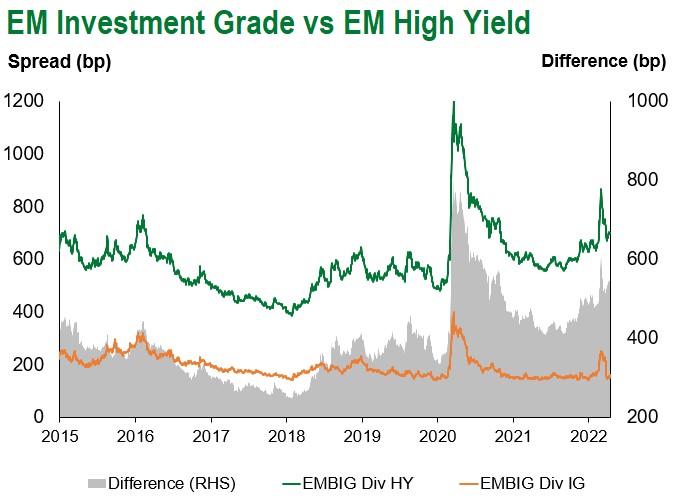
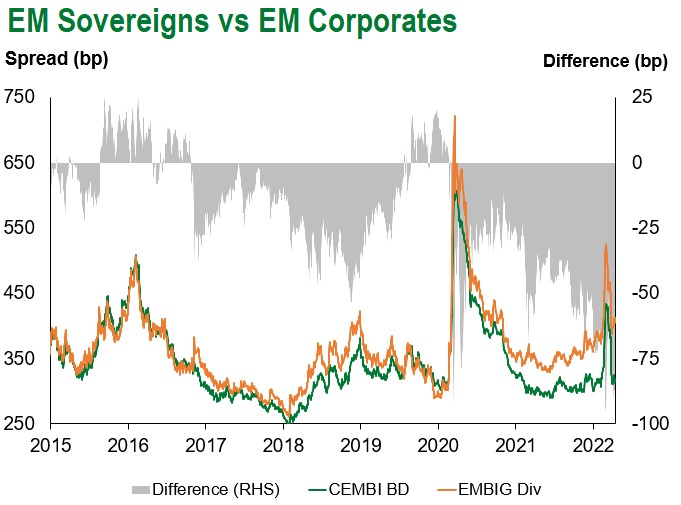
Emerging Markets Flows
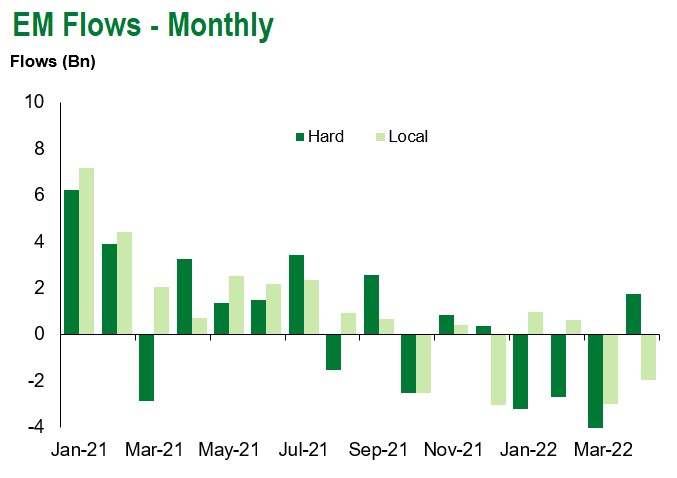
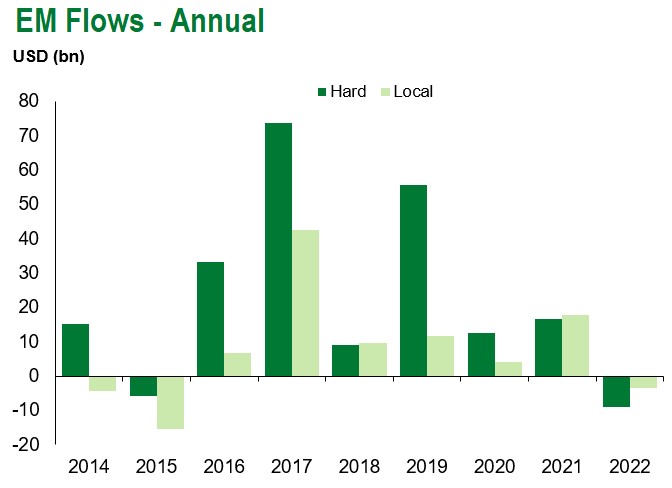
Source for graphs: Bloomberg, JPMorgan, Gramercy. As of April 22, 2022.
COVID Resources
Emerging Markets COVID-19 Case Summary
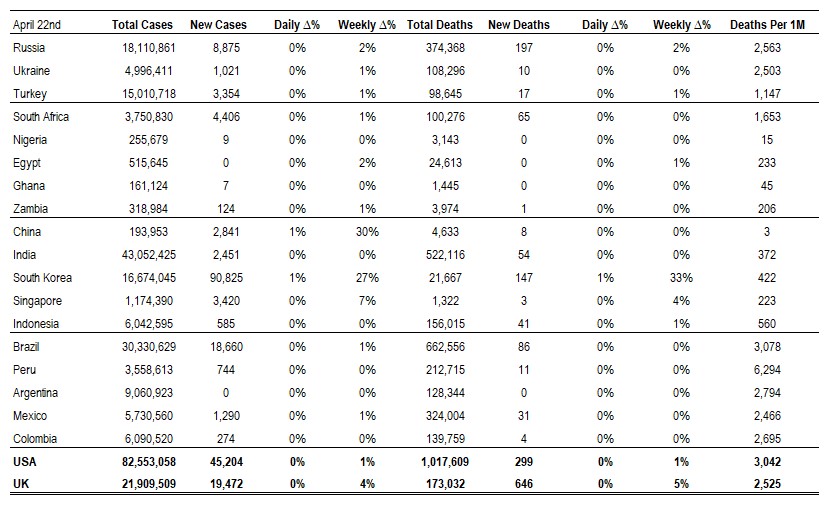
Source: Worldometer as of April 22, 2022.
Additional Crisis Resources:
Johns Hopkins COVID-19 Case Tracker
For questions, please contact:
Kathryn Exum, CFA ESG, Director, Co-Head of Sovereign Research, [email protected]
Petar Atanasov, Director, Co-Head of Sovereign Research, [email protected]
James Barry, Director, Deputy Portfolio Manager, [email protected]
Tolu Alamutu, CFA, Director, Corporate Research Analyst, [email protected]
This document is for informational purposes only. The information presented is not intended to be relied upon as a forecast, research or investment advice, and is not a recommendation, offer or solicitation to buy or sell any securities or to adopt any investment strategy. Gramercy may have current investment positions in the securities or sovereigns mentioned above. The information and opinions contained in this paper are as of the date of initial publication, derived from proprietary and nonproprietary sources deemed by Gramercy to be reliable, are not necessarily all-inclusive and are not guaranteed as to accuracy. This paper may contain “forward-looking” information that is not purely historical in nature. Such information may include, among other things, projections and forecasts. There is no guarantee that any forecasts made will come to pass. Reliance upon information in this paper is at the sole discretion of the reader. You should not rely on this presentation as the basis upon which to make an investment decision. Investment involves risk. There can be no assurance that investment objectives will be achieved. Investors must be prepared to bear the risk of a total loss of their investment. These risks are often heightened for investments in emerging/developing markets or smaller capital markets. International investing involves risks, including risks related to foreign currency, limited liquidity, less government regulation, and the possibility of substantial volatility due to adverse political, economic or other developments. The information provided herein is neither tax nor legal advice. Investors should speak to their tax professional for specific information regarding their tax situation.